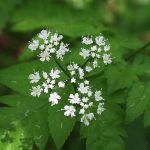| Common Name: |
Aniseroot |
| Other Names: |
Smooth Sweet Cicely, Sweet Myrrh, Wild Chervil, Sweet Jarvil |
| Botanical Name: |
Osmorhiza longistylis |
| Genus: |
Osmorhiza |
| Family: |
Apiaceae |
| Cultivation: |
Moist, well-drained soil in partial shade. |
| Propagation: |
By seed sown when ripe |
| Harvest: |
Leaves are picked when young and used fresh or dried. Unripe and ripe fruits are collected when ready, for use as flavorings. Roots are harvested from late summer to mid-autumn, after the plant has set seed, and used fresh as a vegetable, or dried for use in decoctions and tinctures. |
| Hardiness: |
Z6 |
| Parts Used: |
Leaves, seeds, roots |
| Properties: |
An aromatic herb with soothing, carminative effects and an anise-like scent. Possibly anit-fungal. May stimulate the uterus. |
| Medicinal Uses: |
Internally for sore throat, coughs, digestive complaints, flatulence, debility, kidney problems, and to aid childbirth (roots). Externally for eye problems, ulcers, boils, wounds, and sores. |
| Culinary Uses: |
Leaves and green fruits are eaten raw in salads. Roots are used for flavoring and made into tea. Ripe fruits are used to flavor cakes, candy and liqueurs. |
| Bibliography: |
Encylopedia of Herbs by Deni Brown Copyright ©: 1995, 2001 Dorling Kindersley Limited pg 298
|

